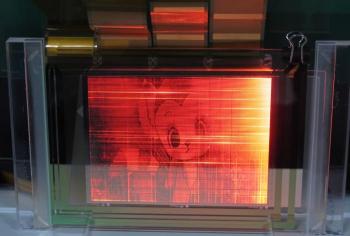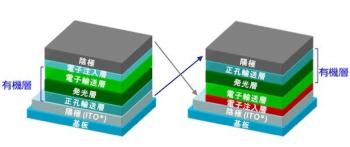Japan Broadcasting Corp (NHK) and Nippon Shokubai developed a new OLED structure (called inverted OLED, or iOLED) that drastically improves oxygen and moisture resistances. The two companies demonstrated a prototype 5" QVGA (320x240, 80 PPI) red monochrome panel that uses the new structure.

The basic iOLED idea is to invert the structure between the electrodes of a bottom-emission OLED. So in an iOLED, on top of a transparent negative electrode (ITO), you place the EIL, ETL, emitter layer, HTL and finally the positive electrodes. According to the two companies, this structure makes the OLED more resistant. The brightness (or light emitting area) of a normal OLED will decrease by half within 100 days if it is exposed to air (due to the oxidation of the negative electrode). An iOLED will will hardly deteriorate in these conditions.

Using this structure, it will be possible to use cheaper and less complicated barrier (encapsulation) technologies and material - and so enable cheaper OLEDs that are easier to produce.


I wonder why? It doesn't make sense...ITO/EIL? What about the voltage and efficiency? And how come it would improve LT? Anyone has any idea?